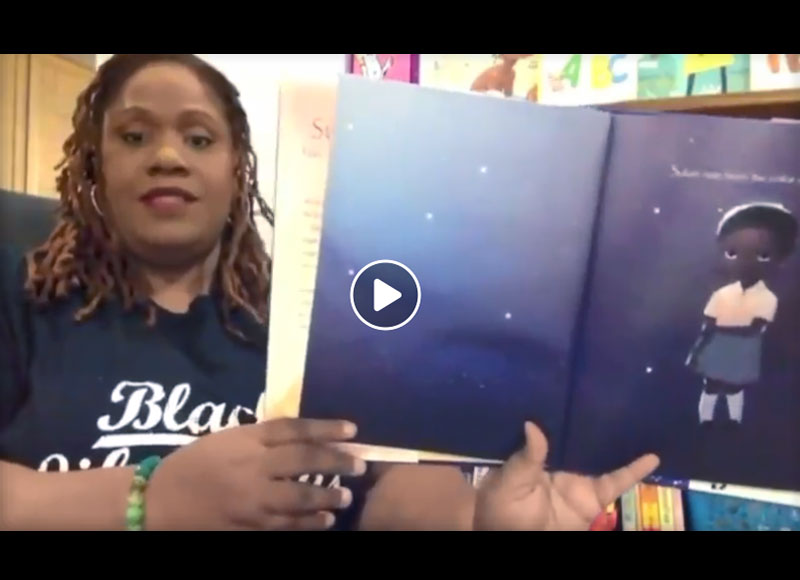Equity and Remote Learning: Strategies from 3 Librarians
Focusing on what kids can access without broadband and where they congregate online, school districts strive to engage all students.
 |
| K.C. Boyd reads aloud Lupita Nyong'o's 'Sulwe' on the Washingon Teachers Union streaming resource "Learning Doesn't Stop: Lessons on TV." |
More than 30 percent of students at Northern Middle School in Accident, MD, lack internet access. While faculty try to create ways to support all children, that inequity has prompted Garrett County Public Schools to rename the idea of distance learning, to “Continuation of Learning,” says school librarian Ali Schilpp. That program will start on April 6, according to Schilpp, SLJ’s 2018 School Librarian of the Year.
Her priority is to try and reach students where they are—whether that’s online or not—and find resources that everyone can use.
 “I have requested to share books at our school's meal site, but it has not been approved as of yet,” Schilpp said by email. “I would also like to move my library’s Little Free Library to that location, but we are not permitted to enter our school building.” Right before her school closed, Schilpp hosted author Dusti Bowling at her library (pictured).
“I have requested to share books at our school's meal site, but it has not been approved as of yet,” Schilpp said by email. “I would also like to move my library’s Little Free Library to that location, but we are not permitted to enter our school building.” Right before her school closed, Schilpp hosted author Dusti Bowling at her library (pictured).
As school districts swiftly move to an online learning environment during the current global pandemic, school librarians like Schilpp are strategizing with educators so all children—including those without broadband or computers—can access the learning they need.
One of Schilpp’s strategies is to use apps that students and parents can access through a smartphone connection. On the school’s Facebook page, she is sharing one free resource at a time, rather than hundreds of links that she knows could overwhelm parents, she says. Schilpp also has a “Teacher’s Pet” forum with photos of teachers with their pets and added a Padlet LEGO Bricks challenge, where students at home can fashion creations based on their favorite books.
"I hope that this keeps our kids engaged and connected to their school and library,” she says. “None of this feels like it's enough. I miss being able to provide a physical space for kids.”
Smartphones not computers
Jefferson Academy’s library media specialist, K.C. Boyd, said the District of Columbia Public Schools uses Microsoft Teams, another platform that can be reached from a smartphone, rather than a computer. That’s crucial, because even though her school is a 1-to-1 space, students could not bring school-issued devices home. Teachers are also thinking about mobile access, reaching students over Instagram, for example, to try and lure them back to online classes.
Boyd's principal also held a Zoom call for parents, students, and faculty. It was a one-hour community meeting that everyone could attend from their phone. Students who attended were also able to win $10 gift cards to a local grocery store, Boyd says. Meanwhile, Boyd is herself posting mini-lessons for parents and teachers, such as her demo on using Instagram Live and Stories. She also has online office hours when parents, teachers, and students can reach her.
“Some teachers are very creative, giving mini-lessons on Instagram Live,” said Boyd. “And if [students] answer, they’re given extra credit, or told they’ll be discussing this in class, so [they should] be ready.”
Physical books
At the five middle and high schools where Denver Public Schools language arts teacher and librarian Julia Torres is assigned to work, most students have Chromebooks assigned to them. Even so, Torres is hoping to focus their attention on something that doesn’t require an internet connection at all: the close to 600 physical books checked out before students left.
“My students still prefer physical books,” said Torres. "And my number one priority is to get them reading and talking about [the books they checked out and brought home.”
She’s thinking about where she could enourage students to congregate online, such as Flipgrid or Sora, nd how they can handle simple projects that don’t require a broadband connection or live classes. That could include having students take a photo with their book, or commenting and discussing a book on GoodReads.
Mostly, though, Torres hopes that everyone—from educators to students—takes time to pause. While some may see having time at home an opportunity to do more, she believes this is an opportunity, instead, to focus on one another.
“How can we be gentler to each other and look out for those who are disadvantaged by the system?” she says. “This is a time for people to take a more human approach, and less of a productivity results-based approach.”
Lauren Barack is a New York-based journalist and the editor of the technology news site GearBrain.com.
RELATED
The job outlook in 2030: Librarians will be in demand
The job outlook in 2030: Librarians will be in demand
ALREADY A SUBSCRIBER? LOG IN
We are currently offering this content for free. Sign up now to activate your personal profile, where you can save articles for future viewing





Add Comment :-
Comment Policy:
Comment should not be empty !!!